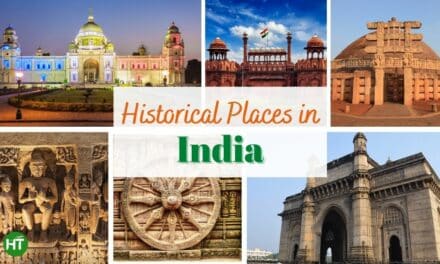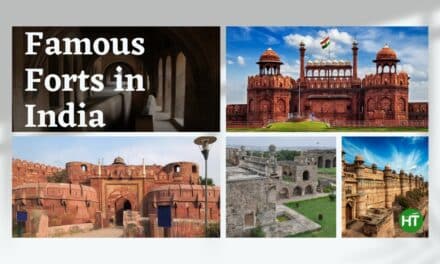Have you ever stood by a lake so calm that it felt like the water was staring back at you? India has many such lakes—beautiful, quiet, and mysterious. But behind the stillness, locals whisper about ghosts, drowning souls, and legends older than time.
Whether you believe in spirits or not, these lakes are full of history, myths, and untold stories. For some, they are holy waters. For others, they are cursed. But one thing is certain—you will never forget them once you visit.
So, here are the top 11 haunted lakes in India, where every ripple carries a story. Visit if you dare!
Why Are Lakes Considered Haunted in India?
In Indian folklore, water is often seen as a gateway between worlds. Many myths talk about rivers and lakes where gods appeared, demons were destroyed, or souls got trapped forever. So, if you search for haunted places in India, the lakes also come in the list.
- Locals believe that lakes keep memories of those who drowned.
- Some lakes are linked with goddesses, curses, or ancient battles.
- Even today, villagers warn travelers not to go near them after sunset.
As one old saying goes: “Paani chup hai, par paap bolta hai.” (Water stays quiet, but sins always speak.)
🏞️ Top 11 Haunted Lakes in India
1. Loktak Lake, Manipur
- The Legend: Loktak is famous for its phumdis (floating islands). Fishermen often speak of ghostly figures appearing in the mist and boats vanishing without a trace.
- History: This is the largest freshwater lake in Northeast India and lifeline of Manipur. Loktak is also home to Keibul Lamjao—the only floating national park in the world.
- How to Reach: From Imphal (50 km), take a taxi or local bus. Nearest airport: Imphal Airport.
- Traveler’s Note: Visit during early morning for stunning sunrise views. But locals warn—don’t stay late at night on the lake.
💡 Interesting Fact: Loktak Lake, covering nearly 287 sq km, is the largest freshwater lake in Northeast India and lifeline of Manipur. Famous for its floating islands (phumdis), it also shelters the endangered Sangai deer inside the world’s only floating national park. Yet, locals believe this beauty hides secrets—fishermen speak of ghostly figures appearing in the mist and boats that never return. At night, strange lights are said to float across the water. Are these just natural gases—or spirits warning fishermen who never return?
2. Rudrasagar Lake, Tripura
- The Legend: Locals believe Lord Shiva once released his anger here, turning the water into a whirlpool that drags careless swimmers down.
- History: On its banks stands Neermahal Palace—the “Lake Palace of the East,” built in 1930 by the Manikya kings.
- How to Reach: Nearest town is Melaghar (2 km). Agartala airport (53 km) is the closest.
- Traveler’s Note: Boating is popular here, but many boatmen refuse late-night rides due to old stories of “disappearing passengers.”
💡 Interesting Fact: Rudrasagar, stretching across 240 hectares, is home to Neermahal Palace, the “Lake Palace of the East.” But villagers claim Lord Shiva once released his anger here, creating whirlpools that drag careless swimmers down. Scientists blame shifting currents, but many boatmen refuse rides after dusk, saying some passengers never reach the shore. For visitors, this mix of royal charm and dark legend makes it one of the eeriest haunted lakes in India.
3. Kamakhya Lake, Assam
- The Legend: Near the famous Kamakhya Temple in Guwahati, this lake is said to turn red during Ambubachi Mela, symbolizing the goddess’s menstruation. People believe powerful spirits guard the lake.
- History: Kamakhya Temple is one of the 51 Shakti Peethas. Devotees come here from across the world.
- How to Reach: Guwahati Railway Station (7 km), Lokpriya Gopinath Bordoloi Airport (20 km).
- Traveler’s Note: Visit during Ambubachi Mela to witness the spiritual energy. But don’t try to test the lake at night—locals say it’s “alive.”
💡 Interesting Fact: Near the world-famous Kamakhya Temple lies a lake that turns red during Ambubachi Mela. Devotees say it marks the menstruation of Goddess Shakti, while scientists argue about iron oxide deposits. Each year, nearly 50,000 pilgrims witness this chilling sight. Isn’t it strange that this miracle happens only once a year? Local priests believe spirits guard the lake, making it one of the most spiritually powerful haunted lakes in India.
4. Naini Lake, Uttarakhand
- The Legend: According to mythology, the goddess Sati’s eye (nain) fell here after her self-immolation. Some visitors claim to see a woman in white near the waters at midnight.
- History: Nainital is named after this very lake. British travelers in the 19th century also wrote about its strange silence.
- How to Reach: Nearest railhead: Kathgodam (35 km). From there, shared taxis and buses go to Nainital.
- Traveler’s Note: The lake looks magical during the day with boating. At night, locals avoid it completely.
💡 Interesting Fact: At 1,938 meters, Naini Lake is the emerald jewel of Nainital. According to mythology, Goddess Sati’s eye (nain) fell here. Some claim to see a woman in white wandering near the lake at midnight. British officers in the 19th century even noted mysterious drownings. Is it just fog illusions—or the restless spirits of the drowned? This blend of history, faith, and folklore makes Naini one of the best-known haunted lakes in India.
5. Roopkund Lake, Uttarakhand (Skeleton Lake)
- The Legend: Known as Skeleton Lake, over 500 human skeletons were found here. Some say they are spirits of a cursed army, others say they were pilgrims struck by a divine storm.
- History: Scientific studies suggest the skeletons are from the 9th century. DNA shows different groups of people died here at different times.
- How to Reach: Nearest railhead: Kathgodam. From there, trek via Lohajung village (3–4 days trek).
- Traveler’s Note: Only visit during summer. Trek is challenging but unforgettable. Many trekkers feel “watched” near the skeletons.
💡 Interesting Fact: Known as Skeleton Lake, Roopkund sits at 16,000 feet and hides over 500 skeletons. DNA tests revealed both Indian and Mediterranean origins, raising questions—how did foreigners reach here centuries ago? Villagers say the dead were cursed pilgrims, while scientists point to hailstorms. Even today, trekkers report hearing whispers on windy nights. Among all haunted lakes in India, this one is truly spine-chilling.
6. Pookode Lake, Kerala
- The Legend: Shaped like the map of India, locals say anyone who tries to count the fish in the lake loses their mind.
- History: Surrounded by evergreen forests and mountains, it is a major tourist attraction in Wayanad.
- How to Reach: Nearest railway station: Kozhikode (60 km). Buses and taxis available to Wayanad.
- Traveler’s Note: Perfect for boating. Just don’t let curiosity make you count the fish!
💡 Interesting Fact: Spread across 8.5 hectares, Pookode is shaped like the map of India. Locals warn that counting its fish leads to madness, and strangely, some tourists have shown odd behavior after trying. Scientists call it suggestion, but can science explain every case? This mix of natural beauty and superstition makes Pookode stand out among haunted lakes in India.
7. Kundala Lake, Kerala
- The Legend: At midnight, travelers claim to hear whispers and laughter across the lake. Some even report boats moving on their own.
- History: Surrounded by tea plantations in Munnar, this lake was once used for hydro projects during British rule.
- How to Reach: Nearest town: Munnar (20 km). Kochi Airport is 130 km away.
- Traveler’s Note: The pedal boats are fun, but avoid after dusk.
💡 Interesting Fact: Surrounded by tea gardens in Munnar, Kundala Lake is breathtaking by day but unsettling by night. Locals talk of whispers in the mist and boats moving without rowers. During the British era, officers recorded unexplained echoes here. Could it just be the valley’s acoustics—or something supernatural? With cherry blossoms blooming twice a year, it’s both romantic and eerie, a rare gem in the list of haunted lakes in India.
8. Pangong Lake, Ladakh
- The Legend: Locals say mountain spirits stir sudden storms and take revenge on arrogant travelers.
- History: One of the highest saltwater lakes in the world (14,000 ft). Famous after the movie 3 Idiots.
- How to Reach: From Leh (160 km), hire a taxi. No direct buses.
- Traveler’s Note: Carry warm clothes—it gets freezing even in summer. The lake is stunning, but its silence feels otherworldly.
💡 Interesting Fact: At 14,000 feet, Pangong Lake stretches across 134 km, with 60% lying in China. Tourists adore its blue waters, but locals fear the sudden storms. Some say mountain spirits stir them when angered. During the India-China conflict, soldiers even reported strange lights. Was it military flares—or something more? Its haunting silence earns Pangong a firm place among the most mysterious haunted lakes in India.
9. Lonar Crater Lake, Maharashtra
- The Legend: Created by a meteor impact 50,000 years ago, locals believe this lake is cursed. Some say it was the spot where Lord Vishnu destroyed a demon. Birds avoid flying directly over the lake due to its magnetic pull.
- History: Scientists confirm its origin from a meteor strike. The water is highly alkaline and saline.
- How to Reach: Nearest railhead: Jalna (90 km). Aurangabad Airport is 122 km away.
- Traveler’s Note: Perfect for adventure travelers. But the eerie silence of the crater is unforgettable.
💡 Interesting Fact: Formed by a meteor strike 52,000 years ago, Lonar Lake is both a scientific wonder and a cursed site in local belief. Myths say Lord Vishnu killed a demon here. The lake’s alkaline waters host microorganisms found nowhere else on Earth. Birds avoid flying directly above it, sparking more fear. Is it magnetic fields—or something darker? This rare natural crater is also one of the strangest haunted lakes in India.
10. Kalapani Lake, Himachal Pradesh
- The Legend: Surrounded by dense forests, villagers say wandering souls cry here at night. Some even believe it’s a path to the afterlife.
- History: The lake’s origins are still unknown, making it even more mysterious.
- How to Reach: Best reached via trekking routes from local villages. Nearest town: Kinnaur region.
- Traveler’s Note: Not a mainstream tourist spot. Go only with a local guide.
💡 Interesting Fact: Hidden deep in Kinnaur, Kalapani is rarely visited by outsiders. Villagers whisper of cries at midnight and shadows moving on the water. The lake’s depth is still unmeasured, giving rise to rumors of it being bottomless. Its name also recalls British-era prisons, where “Kalapani” meant punishment. Could the lake be carrying centuries of suffering? This untouched site is one of the least known but most terrifying haunted lakes in India.
11. Changu (Tsomgo) Lake, Sikkim
- The Legend: At 12,000 ft, locals believe the spirits of lamas guard the lake. Many people have drowned mysteriously, and yaks refuse to go near certain parts.
- History: Sacred to Buddhists. Lamas used to study the lake’s color to predict the future.
- How to Reach: 40 km from Gangtok. Taxis and jeeps available with special permits.
- Traveler’s Note: Visit in summer. In winter, it freezes into a magical sheet of ice.
💡 Interesting Fact: At an altitude of 12,313 feet, Changu Lake freezes into a silver mirror in winter. Monks once studied its changing colors to predict the future. Locals believe spirits of lamas still roam here, and drownings are often unexplained. Even yaks avoid certain parts of the lake. It is also ecologically sensitive, home to rare Brahmini ducks. Tourists adore its beauty, but locals warn: never mock the waters. Science says high altitude causes illusions, but can every sight be explained away? No wonder Changu is one of the most famous haunted lakes in India.
🕰️ Historical and Mythological Connections
Most of these haunted lakes in India are tied to gods, demons, or ancient curses. From Sati’s eye at Naini to Vishnu’s battle at Lonar, they reveal how water is both sacred and feared. These are not just ghost stories—they are cultural memories that keep India’s folklore alive.
🎤 Conclusion – Every Ripple Tells a Tale
Haunted or not, these lakes are museums of myths, culture, and natural wonder. Some will give you goosebumps, others will leave you speechless with beauty.
So the next time you stand by a still, silent lake, remember: every ripple tells a story. Sometimes of gods, sometimes of ghosts, but always of India’s living traditions.
Would you dare to visit one of these lakes? Share your thoughts and let the legends continue.





